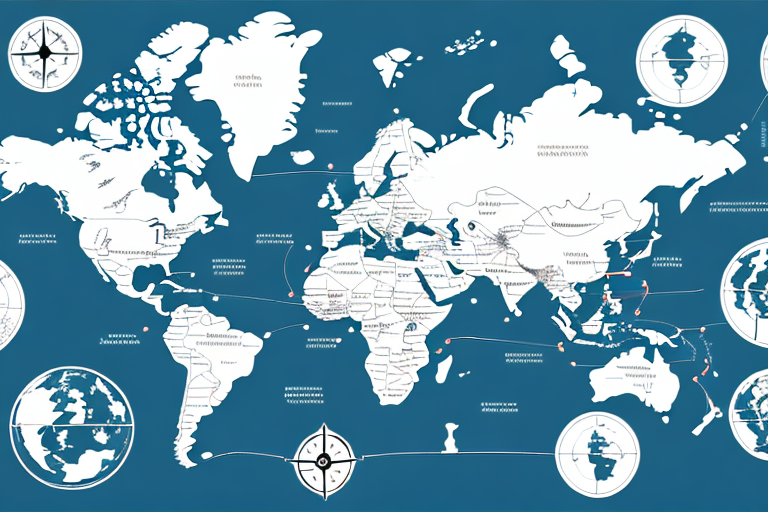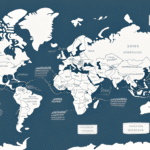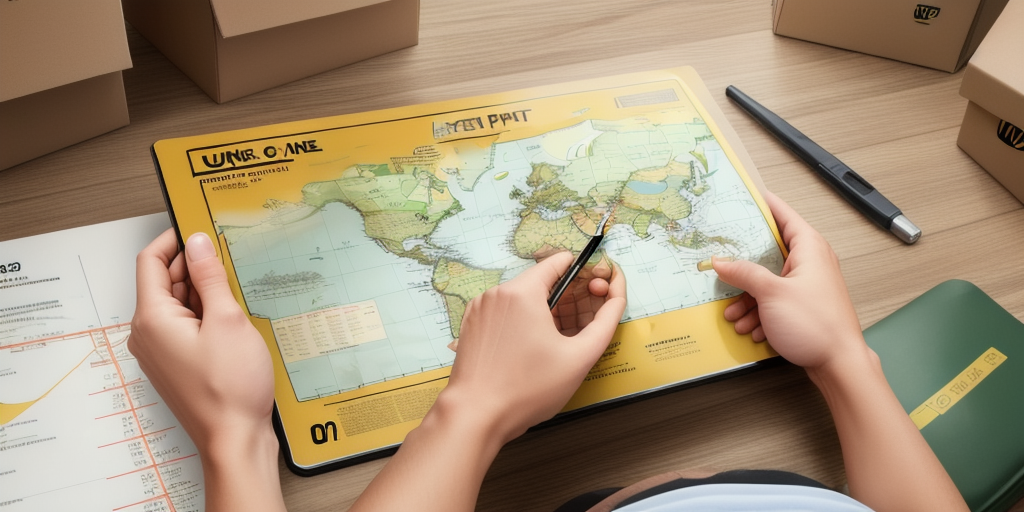Understanding Shipping Zones: A Comprehensive Map
Shipping zones are an important factor for any business that deals with shipping products to customers. By understanding the ins and outs of shipping zones, businesses can optimize their shipping strategies, improve their bottom line, and enhance customer satisfaction. In this article, we’ll break down the basics of shipping zones, why they’re important, key factors that define them, and how businesses can determine and optimize their shipping strategies based on their zone map. We’ll also take a look at some predictions and trends for the future of shipping zones.
Breaking Down the Basics of Shipping Zones
Shipping zones are geographic regions that are used by shipping carriers to determine shipping rates, delivery times, and shipment routes. These zones are typically determined by factors such as distance, postal codes, and regional boundaries. Each shipping carrier has its own zone map and system of rates, making it important for businesses to understand the specific zone map of the carriers they use.
Shipping zones are typically divided into different tiers or levels, with rates increasing as the distance from the origin point increases. For example, a business shipping a product from New York to Florida will typically pay less for shipping than a business shipping the same product from New York to California. By understanding these tiers and rates, businesses can better plan their shipping budget and optimize their shipping strategies.
It’s important to note that shipping zones can also affect delivery times. Carriers may have different delivery schedules for different zones, with longer delivery times for more distant zones. Businesses should take this into account when planning their shipping timelines and communicating with customers about expected delivery dates.
Another factor that can impact shipping zones is the type of product being shipped. Some carriers may have restrictions or additional fees for shipping certain types of products, such as hazardous materials or oversized items. Businesses should be aware of these restrictions and fees when selecting a carrier and planning their shipments.
Why Understanding Shipping Zones is Crucial for Your Business
Understanding shipping zones is crucial for any business that ships products to customers. By optimizing shipping strategies based on zone maps, businesses can save money on shipping costs, improve delivery times, and offer better customer service. Shipping costs can make up a significant portion of a business’s overhead, and by understanding shipping zones, businesses can negotiate better rates and save money in the long run.
For businesses that offer free or subsidized shipping to customers, understanding shipping zones is especially important. By optimizing shipping strategies based on zone maps, businesses can offer free or subsidized shipping to customers in certain zones, while still maintaining profitability.
Another benefit of understanding shipping zones is the ability to accurately estimate delivery times. By knowing the distance between your business and the customer’s location, you can provide more accurate delivery estimates. This can help improve customer satisfaction and reduce the number of inquiries about delivery status. Additionally, understanding shipping zones can help businesses identify areas where they may need to expand their distribution network to reach customers in more remote or underserved areas.
The Key Factors That Define Shipping Zones
There are several key factors that define shipping zones, including distance, regional boundaries, and postal codes. Shipping carriers use complex algorithms and data analysis to determine the specific zone map for their services, taking into account factors such as delivery times, transportation routes, and infrastructure.
Postal codes are a common way to define shipping zones, as they provide a clear and easily identifiable location for carriers to use in their calculations. Some carriers may also use regional boundaries or geographic features, such as state borders or major highways, to define shipping zones.
Another important factor that can define shipping zones is the type of goods being shipped. Some carriers may have specific zones for hazardous materials or oversized items, which require special handling and transportation. Additionally, the weight and size of the package can also impact the shipping zone, as carriers may have different rates and requirements for larger or heavier packages.
Finally, the destination of the package can also play a role in defining shipping zones. International shipments may have different zone maps and rates than domestic shipments, and carriers may have specific zones for certain countries or regions. It’s important for shippers to understand the specific zone map and requirements for their package to ensure timely and cost-effective delivery.
How to Determine Your Shipping Zone
The easiest way to determine your shipping zone is to check the zone map of the carrier you use. Most carriers provide online tools or calculators that allow businesses to enter their origin and destination zip codes and receive an estimate of shipping costs and delivery times. Businesses can use these tools to determine their shipping zone and calculate the most cost-effective shipping strategy for their needs.
It’s important to note that shipping zones can vary depending on the carrier and the type of service selected. For example, some carriers may have different zones for ground shipping versus air shipping. Additionally, certain carriers may have different zone boundaries for international shipments. It’s always a good idea to double-check the carrier’s zone map and shipping policies to ensure accurate and efficient shipping.
A Guide to the Different Types of Shipping Zones
There are several different types of shipping zones that businesses should be aware of. Domestic shipping zones refer to shipping within a single country, while international shipping zones refer to shipping between different countries. Some carriers may also offer specialized shipping zones, such as those for hazardous materials or large freight.
Businesses should also be aware of the different tiers or levels within a shipping zone, as rates can vary widely depending on the distance from the origin point. Some carriers may also offer regional or local shipping zones, which can provide more cost-effective shipping options for businesses in certain areas.
It is important for businesses to understand the different factors that can affect shipping rates within a shipping zone. These factors can include the weight and size of the package, the mode of transportation, and the delivery timeframe. Additionally, businesses should be aware of any restrictions or regulations that may apply to certain types of shipments, such as those containing perishable goods or dangerous materials.
What You Need to Know About Domestic vs International Shipping Zones
When shipping products internationally, businesses must be aware of the different shipping zones and rates. International shipping zones are typically more complex than domestic ones, with a wider range of rates and delivery times. Businesses must also take into account factors such as customs regulations, tariffs, and currency exchange rates when shipping internationally.
It’s important for businesses to choose a carrier with experience and expertise in international shipping, as the process can be more complex and time-consuming than domestic shipping. Carriers that offer international shipping should also provide clear and detailed information about their international shipping zones and rates, as well as guidance on customs regulations and other factors that may affect the shipping process.
Another important factor to consider when shipping internationally is packaging. Products must be packaged securely and appropriately for international shipping, as they may be subject to longer transit times and more handling. Businesses should also be aware of any specific packaging requirements or restrictions for the destination country.
The Pros and Cons of Using Different Shipping Carriers for Different Zones
Businesses may choose to use different shipping carriers for different zones based on factors such as rates, delivery times, and customer preferences. While this can provide more flexibility and cost-effective shipping options, it may also require more time and resources to manage multiple carriers.
Using multiple carriers may also require businesses to negotiate and manage different rates, contracts, and service levels. However, by choosing the right carrier for each zone and taking advantage of competitive rates and services, businesses can optimize their shipping strategies and provide better customer service.
How to Optimize Your Shipping Strategy Based on Your Zone Map
There are several strategies and tactics businesses can use to optimize their shipping strategies based on their zone map. By understanding the different tiers and rates within their zone, businesses can choose the most cost-effective shipping options for their needs.
Using shipping software or services can also help businesses to optimize their shipping strategy, by providing real-time rate comparisons, parcel tracking, and other tools to simplify the shipping process. Businesses should also regularly review their shipping strategy and carrier contracts to ensure they are maximizing their savings and resources.
Common Mistakes to Avoid When it Comes to Shipping Zones
There are several common mistakes businesses should avoid when managing shipping zones, including:
- Failing to regularly review and update shipping strategies
- Ignoring carrier-specific zone maps and requirements
- Underestimating the impact of packaging on shipping costs
By avoiding these common mistakes and staying up-to-date on industry trends and best practices, businesses can optimize their shipping strategy and provide better service to their customers.
Tips for Negotiating Better Rates Based on Your Shipping Zone
Negotiating better rates with carriers can be a key part of optimizing a business’s shipping strategy. Some tips for negotiating better rates based on your shipping zone include:
- Gathering and analyzing shipping data to understand your needs
- Comparing rates from multiple carriers
- Leveraging volume discounts and long-term contracts
By being proactive and informed when it comes to carrier negotiations, businesses can save money on shipping costs and improve their bottom line.
The Future of Shipping Zones: Trends and Predictions
The world of shipping is constantly evolving, with new technology and trends shaping the industry. Some predictions and trends for the future of shipping zones include:
- Increased use of automation and AI in logistics
- Expansion of regional and local shipping services
- Adoption of sustainable and eco-friendly shipping practices
By staying current on these trends and anticipating the future of shipping zones, businesses can continue to optimize their shipping strategies and provide better service to their customers.




















